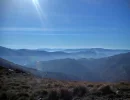M
mikevasey
Guest
When I walked the above section in 2010, the hopitalero at the Soto de Luina albergue advised the pilgrims to go the road way and also to avoid the off road way, it being overgrown and poorly waymarked, being a good pilgrim I followed his advice and followed the road. However 3 pilgrims from Majorca got mixed up and went the not reccommended way, the Mountain Way, they later showed me their photos, they said it was hard but incredibly beautiful and waymarked. My day had not been that bad, but almost 23km on asphalt makes your feet sore and tender, I did have the advantage of being able every now and then to go into cafes, they did not. Since then every chance I get I look up this alternative route to see what is being said about it, most reviews seem to say it is doable, I recently saw the 2013 updated cicerone guide to the Norte and it advised pilgrims that it was not. To give some more balance to this I thought I would add this website I have just come across, it is in Spanish but can be translated into English www.xurdemoran.blogspot.co.uk/2014/06/el-camino-de-la-sierra-de-las-palancas.html


























